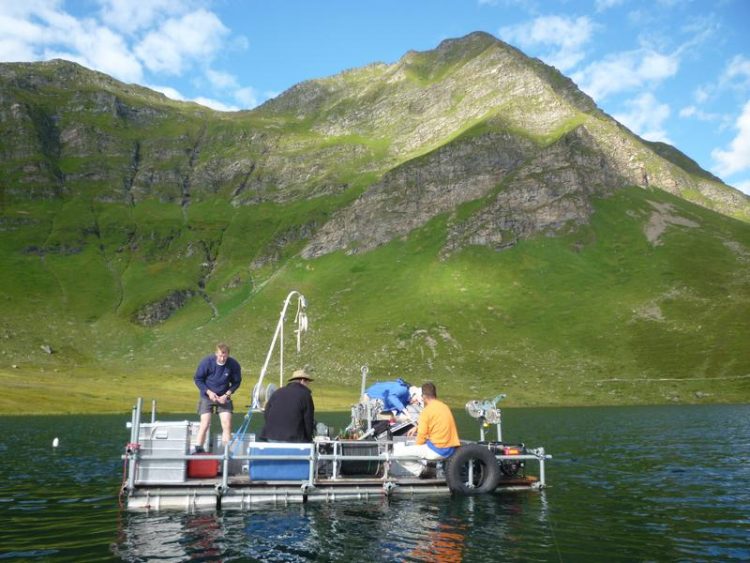Methane consumption by aerobic bacteria in anoxic lake waters

Sampling was performed from a platform on Lake Cadagno in Canton Ticino (southern Switzerland). Jana Milucka, Max Planck Institute for Marine Microbiology, Bremen
Methane emissions are strongly reduced in lakes with anoxic bottom waters. But here – contrary to what has previously been assumed – methane removal is not due to archaea or anaerobic bacteria. A new study on Lake Cadagno in Canton Ticino shows that the microorganisms responsible are aerobic proteobacteria. The oxygen they require is produced in situ by photosynthetic algae.
In contrast to oceans, freshwater lakes – and tropical reservoirs – are significant sources of methane emissions. Methane, a greenhouse gas, arises from the degradation of organic material settling on the bottom. Although lakes occupy a much smaller proportion of the Earth’s surface than oceans, they account for a much larger proportion of methane emissions.
Well-mixed lakes, in turn, are the main contributors, while emissions from seasonally or permanently stratified lakes with anoxic bottom waters are greatly reduced. It has been assumed to date that the methane-removing processes occurring in such lakes are the same as those in marine systems. But a new study carried out on Lake Cadagno (Canton Ticino) by researchers from Eawag and the Max Planck Institute for Marine Microbiology (Bremen, Germany) shows that this is not the case.
The scientists demonstrated that methane is almost completely consumed in the anoxic waters of Lake Cadagno, but they did not detect any known anaerobic methane-oxidizing bacteria – or archaea, which are responsible for marine methane oxidation. Instead, water samples collected from a depth of around 12 metres were found to contain abundant aerobic proteobacteria – up to 240,000 cells per millilitre.
“We wondered, of course, how these aerobic bacteria can survive in anoxic waters,” says first author Jana Milucka of the Max Planck Institute for Marine Microbiology. To answer this question, the behaviour of the bacteria was investigated in laboratory experiments: methane oxidation was found to be stimulated only when oxygen was added to the samples incubated in vitro, or when they were exposed to light.
The scientists concluded that the oxygen required by the bacteria is produced by photosynthesis in neighbouring diatoms. Analysis by fluorescence microscopy showed that methane-oxidizing bacteria belonging to the family Methylococcaceae occur in close proximity to diatoms and can thus utilize the oxygen they generate (Fig. 2).
Thanks to the combined activity of bacteria and diatoms, methane is thus consumed in the lake rather than being released into the atmosphere. This type of methane removal has not previously been described in freshwater systems. Project leader Carsten Schubert of Eawag comments: “For lakes with anoxic layers, and also for certain marine zones, it looks as if the textbooks will have to be rewritten.”
Aerobic methane-oxidizing bacteria may play a significant role wherever sufficient light penetrates to anoxic water layers; according to Schubert, this is the case in most Swiss lakes. Similar observations have already been made in Lake Rotsee near Lucerne, in studies not yet published. Research will now focus on deeper lakes, where initial investigations suggest that different processes occur.
Further information:
CH: Carsten Schubert, Eawag: +41 (0)58 765 2195; carsten.schubert@eawag.ch
D: Marcel Kuypers, Max Plank Institute for Marine Microbiology, Bremen: +49 421 2028 602; mkuypers@mpi-bremen.de
or from the press officer
Manfred Schloesser, Max Plank Institute for Marine Microbiology, Bremen: +49 421 2028 704; mschloes@mpi-bremen.de
Original article
Methane oxidation coupled to oxygenic photosynthesis in anoxic waters; Jana Milucka, Mathias Kirf, Lu Lu, Andreas Krupke, Phyllis Lam, Sten Littmann, Marcel MM Kuypers and Carsten J Schubert; The ISME Journal (International Society for Microbial Ecology), advance online publication, 13 February 2015; doi:10.1038/ismej.2015.12;
Media Contact
More Information:
http://www.mpi-bremen.deAll latest news from the category: Earth Sciences
Earth Sciences (also referred to as Geosciences), which deals with basic issues surrounding our planet, plays a vital role in the area of energy and raw materials supply.
Earth Sciences comprises subjects such as geology, geography, geological informatics, paleontology, mineralogy, petrography, crystallography, geophysics, geodesy, glaciology, cartography, photogrammetry, meteorology and seismology, early-warning systems, earthquake research and polar research.
Newest articles

Silicon Carbide Innovation Alliance to drive industrial-scale semiconductor work
Known for its ability to withstand extreme environments and high voltages, silicon carbide (SiC) is a semiconducting material made up of silicon and carbon atoms arranged into crystals that is…

New SPECT/CT technique shows impressive biomarker identification
…offers increased access for prostate cancer patients. A novel SPECT/CT acquisition method can accurately detect radiopharmaceutical biodistribution in a convenient manner for prostate cancer patients, opening the door for more…

How 3D printers can give robots a soft touch
Soft skin coverings and touch sensors have emerged as a promising feature for robots that are both safer and more intuitive for human interaction, but they are expensive and difficult…




















